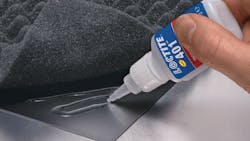|
Andrew Scott |
Cyanoacrylates (CAs) are one-part adhesives that set or fixture rapidly and cure at room temperature. The adhesives bond a wide range of components, providing excellent adhesion to metals, plastics, elastomers, and porous substrates.
Cyanoacrylates polymerize when exposed to water, a weak base present in trace amounts on virtually all surfaces. Water neutralizes acidic stabilizers in the adhesive, initiating rapid cure. CAs reach fixture strength in just seconds and full strength within 24hr, and form highstrength bonds when fully cured.
Cyanoacrylates are easy to use and well suited for automated dispensing. For manufacturers, fast curing increases throughput and reduces per-piece processing costs.
Recent advances
The latest cyanoacrylate innovations include surface- insensitive adhesives with shorter fixture times, stronger bonds, and better temperature resistance. In addition, new low-odor, low-bloom formulas greatly improve humidity resistance.
Loctite 401 adhesive is a cyanoacrylate designed for difficultto- bond materials which require uniform stress distribution. It is suited for closefitting applications with metals, plastics, and elastomers.New surface-insensitive cyanoacrylates speed assembly by fixturing substrates such as metals, plastics, and elastomers in 15sec or less. By minimizing the effect of surface acidity and dryness, these cyanoacrylates generally offer the shortest fixture times of all CAs.
Invented in the 1950s and introduced to industrial users in the 1970s, traditional general-purpose, surfaceinsensitive instant adhesives offer bond strengths to 3,200lb, but typically withstand operating temperatures of no more than 180°F.
The next generation of higher-temperature instant adhesives, introduced in the late 1980s, withstood maximum operating temperatures of 250°F. But gaining heat resistance compromised both strength and fixture speed. For example, this class of higher-temperature CAs requires approximately 90sec to fixture and offers bond strength of 2,300lb.
Loctite 406 is a fast-curing, surfaceinsensitive cyanoacrylate adhesive. The one-part adhesive cures at room temperature and is designed for OEM assembly of plastics and elastomeric materials that require fast fixturing.Today’s newest surface-insensitive instant adhesives combine the best of both previous generations. They now withstand consistent 250°F operating temperatures, fixture in just 15sec, and offer bond strength of 3,200lb. That’s a significant improvement in temperature resistance over traditional, first-generation CAs. And compared to second-generation high-temperature CAs, today’s versions improve bond strength by nearly 40% and reduce fixture time by 75sec, cutting processing time 80%.
New low-odor, low-bloom instant adhesives virtually eliminate pungent odors that can pose a safety concern for manufacturers operating in confined spaces and in areas with low airflow. These instant adhesives are also less likely to cause blooming, a white haze that can form on an assembly around the bond line. This improves aesthetics of the final product. Although bloom is desired in some CA applications like fingerprint detection, it is more often viewed as a detriment where clean bond lines are crucial — such as on cosmetic cases, appliances, and medical devices.\
Low-odor, low-bloom (LOLB) adhesives are formulated using cyanoacrylate monomers with higher molecular weights than those of traditional CAs. Higher-weight molecules make the adhesive less likely to become airborne than standard cyanoacrylate monomers. Lower-weight CA molecules, on the other hand, tend to become airborne and transport odors to the surroundings, affecting anyone in the assembly area. Airborne molecules also eventually settle back onto assemblies as white flakes which, in great numbers, give parts a hazy or frosted appearance.
Another improvement: first-generation LOLB cyanoacrylates could not tolerate operating temperatures greater than 160°F; the latest ones resist temperatures as high as 200°F.
Early-generation products also performed poorly in humid environments. New LOLB formulations eliminate these concerns. For example, the latest versions retain 50% of their shear strength after 1,000-hr exposure to humidity. Early generation LOLB adhesives retained only 10% of their strength after long-term exposure to humid conditions.
Additional benefits
The higher temperature ratings of new-generation CAs bring a number of benefits to manufacturers. When maximum temperature ratings were only 180°F, traditional CAs were often passed over in assembly applications in favor of higher-temperature, non-CA instant adhesives that compromised fixture times and bond strength. Or manufacturers turned to alternative but slower-curing adhesives such as acrylics, epoxies, and silicones.
By raising the temperature threshold, new fast-fixturing, high-strength CAs can replace slower-curing adhesives in applications to 250°F. Faster application and fixture times mean smaller work-in-process inventories for manufacturers and less space required to rack products waiting for adhesives to cure. In addition, onecomponent cyanoacrylates eliminate the added cost of scrap inherent with two-component adhesives, for example due to clogged mixing nozzles and offratio adhesive streams that don’t cure properly.
Low-odor, low-bloom instant adhesives let manufacturers design and assemble products that withstand exposure to high heat and humidity while reducing costs associated with slower fixture speeds and weaker bond lines. They’re suited for a broad spectrum of finished products including cosmetic cases, small appliances, power equipment, smartphones, handheld devices, computers, and speakers.
About the Author
Kenneth Korane
Ken Korane holds a B.S. Mechanical Engineering from The Ohio State University. In addition to serving as an editor at Machine Design until August 2015, his prior work experience includes product engineer at Parker Hannifin Corp. and mechanical design engineer at Euclid Inc.
